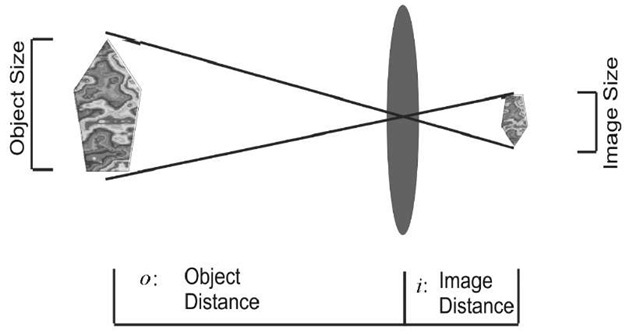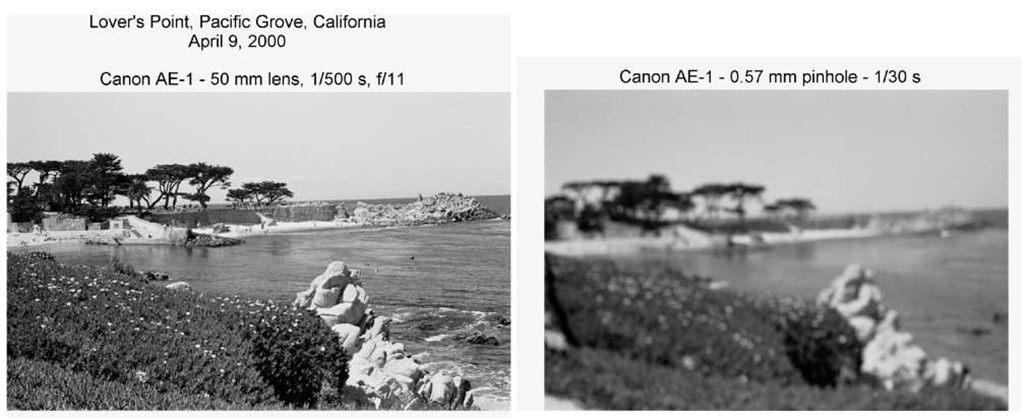The sequence of physical processes considered here has followed the photons from the source (generally, the sun for visible imaging) and through the atmosphere. The energy now needs to be detected by a sensor. This requires an optical system and detectors. The simplest aspects of optical systems are considered here; our primary concern is the factors that define resolution.
Focal length/geometry
The most fundamental equation in optics is the thin-lens equation:
Here f is the focal length, an intrinsic characteristic of the lens determined by the radius of curvature and the index of refraction of the lens material (or materials). The distances from the center of the lens to the object o and to the image i are the other two parameters. We see that the focal length defines the image distance when o, the object distance, is infinity![]() . In the illustration here, the object distance is twice the focal length, so the image distance is also twice the focal length
. In the illustration here, the object distance is twice the focal length, so the image distance is also twice the focal length![]() .
.
Figure 3.17 The thin-lens law.
Optical diagram: similar triangles, magnification
The old geometry law holds that similar triangles determine the size of the image—the magnification is equal to the ratio of the image distance to the object distance. In the example above, the two are equal, so the image has the same size as the object. Normally, in remote sensing, the object distance is a large number, while the image distance is roughly the focal length. For example, the Hasselblad camera used by early astronauts was typically used with a 250 mm lens at an altitude of 150 km. So the ratio of image size to object is![]()
which is a pretty small number. The Monterey Peninsula (extending some 20 km from north to south in central California) would be imaged on a piece of film 32 mm in length (about half the width of the 70-mm film rolls). The Corona (KH4) missions introduced at the beginning of this topic had 61-cm focal-length optics. 
Figure 3.18 Magnification: similar triangles.
Aperture (f/stop)
The light-gathering ability of a lens is defined by its diameter. More sensitive optical systems have larger (faster) optics. The effectiveness of a given aperture depends upon the focal length (the magnification). This dependence is defined by the concept of the![]() as the ratio of the focal length to the lens (or mirror) diameter:
as the ratio of the focal length to the lens (or mirror) diameter:
Typical lenses found on amateur cameras will vary from f/2.8 to f/4. High-quality standard lenses will bef/1.2 tof/1.4 for 35 mm cameras. The longer the focal length (the higher the magnification), the larger the lens needs to be to maintain a similar light-gathering power. The longer the focal length, the harder it is to create a fast optic. A telephoto for a sports photographer might be 500 mm and might at best be f/8 (question: what is the diameter implied by that aperture?). Note that two different quantities are being referred to as "f" here, following optical convention. One is the focal length; the other is the aperture.
As mentioned at the beginning of this topic, the KH4-B cameras had a focal length of 24 inches and were 5-10 inches in diameter.Apertures of f/4 to f/5.6 are typical of the early systems. By contrast, we’ll see that the Hubble Space Telescope is characterized by aperture values of f/24 andf/48, depending on the optics following the big primary mirror.
Supplemental topic: Optical systems made with lenses need to pay attention to the transparency of the material in the spectral range of interest. Glass is transparent from ~400 nm into the infrared. UV sensors and MWIR/LWIR sensors need to be constructed from special materials making them much more expensive.
Image formation by lens or pinhole
Once the image has formed on the focal plane (for example, on film), an image can be recorded. This is illustrated by a pair of images taken with a 35 mm camera. The image on the left in Fig. 3.19 was taken with a normally employed 50 mm lens.14
Figure 3.19 Two images of the shoreline. The pinhole is effectively a 50 mm lens stopped down to an aperture of approximately 0.57mm, or approximately f/100.
The image to the right was taken with the same camera, but without the lens. Instead, a piece of aluminum foil was pierced with a pinhole and fastened on a lens cap at the front of the camera, approximately 50 mm from the film plane. The pinhole’s diameter was approximately 1% that of the normal lens.
The pinhole image obtained is fuzzy; the smaller the pinhole, the sharper the image will be. The problem with a small aperture is, of course, relatively long exposure time. A limit is eventually reached as diffraction effects emerge, as described in the next section.




